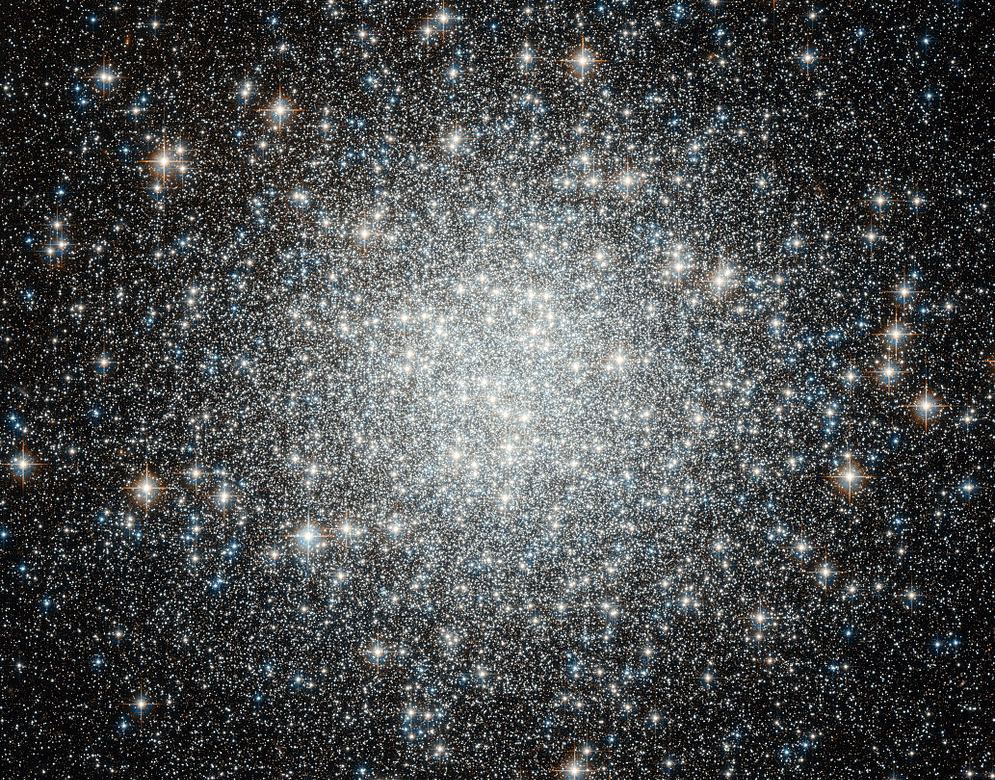Welcome back to Messier Monday! In our ongoing tribute to the great Tammy Plotner, we take a look at globular cluster known as Messier 53!
During the 18th century, famed French astronomer
Charles Messier
noted the presence of several "nebulous objects" in the night sky. Having originally mistaken them for comets, he began compiling a list of these objects so others would not make the same mistake he did. In time, this list (known as the
Messier Catalog
) would come to include 100 of the most fabulous objects in the night sky.
One of these objects is Messier 53, a globular cluster located in the northern
Coma Berenices
constellation. Located about 58,000 light years from the Solar System, it is almost equidistant from Galactic Center (about 60,000 light years). As Messier Objects go, it is relatively easy to find since it lies in the same area of the sky as Arcturus, the fourth brightest star in the night sky.
Description:
Heading towards us at a speed of 112 kilometers per second, globular cluster M53 is one of the furthest distant globular clusters in our Milky Way halo and lay almost equally distant between our solar system and the galactic center. This 220 light year diameter ball of stars in tightly compacted towards its core - where low metal is the name of the game and RR Lyra type variable stars once ruled. But recent studies have found that there are some new kids on the block. The blue stragglers...
[caption id="attachment_136686" align="aligncenter" width="580"]
Messier 53, as imaged by the Hubble Space Telescope. Credit: ESA/Hubble & NASA
[/caption]
According to G. Beccari (et al) the population of these definitely appears to violate standard theories of stellar evolution. And there not just a few blues... There's a whole host of them. As Beccari noted in a
2008 study
:
Is this possible? Then take a closer look into this research. One where a millisecond pulsar was discovered inside. As S.R. Kulkarni (et al) indicated in a
1991 study
:
[caption id="attachment_136685" align="aligncenter" width="580"]
The Messier 53 globular star cluster. Credit: Ole Nielsen
[/caption]
History of Observation:
This globular cluster was first discovered on February 3, 1775 by Johann Elert Bode, but independently recovered on February 26, 1777 by Charles Messier who writes:
Sir William Herschel would revisit M53, but he did not publish his findings when studying Messier objects. Very seldom did Herschel wax poetic in his writings, but of this particular object he said: "A cluster of very close stars; one of the most beautiful objects I remember to have seen in the heavens. The cluster appears under the form of a solid ball, consisting of small stars, quite compressed into one blaze of light, with a great number of loose ones surrounding it, and distinctly visible in the general mass."
He would return again in later years to include in his notes: "From what has been said it is obvious that here the exertion of a clustering power has brought the accumulation and artificial construction of these wonderful celestial objects to the highest degree of mysterious perfection."
[caption id="attachment_136687" align="aligncenter" width="580"]
The Messier 53 globular cluster. Credit: NASA/ESA/Hubble
[/caption]
Although it did not touch Sir John Herschel quite so much, M53 also engaged Admiral Smyth who wrote:
Locating Messier 53:
M53 can be easily found just about a degree northeast of 42 Alpha Comae Berenices, a visual binary star. To located Alpha, draw a mental line from Arcturus via Eta Bootis where you'll see it about a fist width west. Alternately you can starhop from Gamma Viginis to Delta and on to Epsilon where you can locate M53 approximately 4 fingerwidths to the north/northeast.
To see this small globular cluster in binoculars will require dark skies and it will appear very small, like a large, out of focus star. In small telescopes it will appear almost cometary - and thus why Messier cataloged these objects! However, with telescopes approaching the 6" range, resolution will begin and larger telescopes will shatter this gorgeous globular cluster. Requires dark skies.
[caption id="attachment_136682" align="aligncenter" width="580"]
The location of Messier 53 in the northern Coma Berenices constellation. Credit: IAU and Sky & Telescope magazine (Roger Sinnott & Rick Fienberg)
[/caption]
A ball of worlds... What a unique description! May you enjoy your observations as well!
And here are the quick facts on this Messier Object to help you get started!
- Object Name
-
Messier 53
- Alternative Designations
-
M53, NGC 5024
- Object Type
-
Class V Globular Cluster
- Constellation
-
Coma Berenices
- Right Ascension
-
13 : 12.9 (h:m)
- Declination
-
+18 : 10 (deg:m)
- Distance
-
58.0 (kly)
- Visual Brightness
-
7.6 (mag)
- Apparent Dimension
-
13.0 (arc min)
We have written many interesting articles about Messier Objects here at Universe Today. Here's Tammy Plotner's
Introduction to the Messier Objects
, ,
M1 – The Crab Nebula
,
M8 – The Lagoon Nebula
, and David Dickison's articles on the
2013
and
2014
Messier Marathons.
Be to sure to check out our complete
Messier Catalog
. And for more information, check out the
SEDS Messier Database
.
Sources:
- Messier Objects - Messier 53
- *SEDS - Messier 53*
- Wikipedia - Messier 53
 Universe Today
Universe Today
